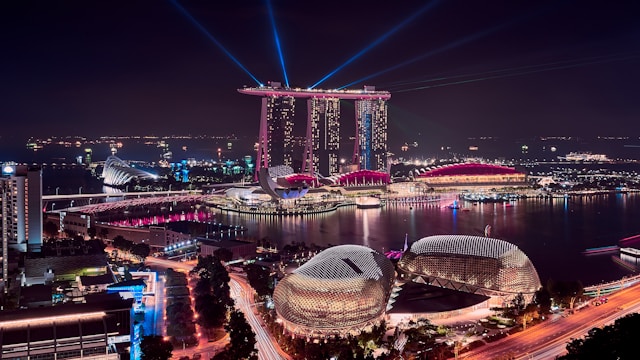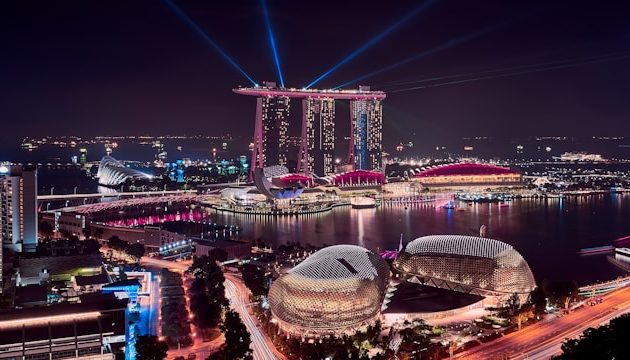
Singapore, renowned for its strategic growth and modern cityscape, has taken a bold step forward in creating a greener and more sustainable environment for its residents. This densely populated island nation has implemented innovative and comprehensive environmental policies aimed at sustainable urban living. In the heart of this transformation, Singapore has not only emphasized eco-friendly initiatives but has also shown the world how a small, highly urbanized country can lead by example in building a future-ready city. Here, we’ll explore the main facets of Singapore’s dedication to sustainability, covering energy efficiency, green architecture, water conservation, waste management, and urban biodiversity.
Green Infrastructure: Sustainable Architecture in Singapore
Singapore has established itself as a global pioneer in green infrastructure by integrating sustainable architecture into urban development projects. The government mandates that new buildings must meet high standards of environmental sustainability, encouraging architects to incorporate natural ventilation, energy-efficient lighting, and solar panels.
For instance, the iconic Marina Bay Sands Hotel and Gardens by the Bay showcase how green architecture can seamlessly integrate into a bustling city. These sites highlight the city’s commitment to green design by employing energy-efficient cooling systems and renewable energy sources. Additionally, the Super Tree Grove at Gardens by the Bay serves as a symbol of green infrastructure, featuring vertical gardens that double as solar panels, rainwater collectors, and ventilation ducts.
The Green Mark Scheme—an initiative launched by Singapore’s Building and Construction Authority (BCA)—certifies buildings based on their eco-friendliness. This program incentivizes the construction of environmentally sustainable buildings, setting benchmarks for energy conservation, water efficiency, and indoor environmental quality. Since its inception, Green Mark has certified thousands of buildings, transforming Singapore’s skyline into a model of eco-friendly urbanism.
Energy Efficiency: Harnessing Renewable Energy in an Urban Setting
Given its limited natural resources, Singapore has turned to innovative methods for energy conservation and the adoption of renewable energy sources. The city-state’s tropical climate poses challenges, yet Singapore has responded by implementing effective energy-saving policies. Solar energy, in particular, has been at the forefront of Singapore’s renewable energy ambitions, with a goal to quadruple solar energy capacity by 2025.
The SolarNova Program spearheaded by the government is designed to boost solar energy adoption by installing photovoltaic panels on public housing estates and government buildings. This initiative not only reduces dependency on traditional power sources but also aligns with Singapore’s commitment to the Paris Agreement goals of reducing greenhouse gas emissions. Alongside solar energy, Singapore has explored other renewable energy sources, including hydrogen, which is still in its experimental phase but holds promise as a sustainable energy alternative.
In addition to renewable energy sources, Singapore encourages the use of smart technology for optimizing energy consumption. Smart meters, energy-efficient appliances, and intelligent building management systems are becoming commonplace, helping Singapore manage and reduce energy usage across households and businesses alike.
Water Conservation: Efficient Water Management and Self-Sufficiency
As a country with limited natural freshwater resources, water conservation is of paramount importance to Singapore. Over the years, Singapore has developed a diversified water supply strategy known as the “Four National Taps.” These taps include local catchment areas, imported water, desalinated water, and the country’s own water recycling program, known as NEWater.
The implementation of the NEWater initiative has been transformative. Through advanced membrane technologies, Singapore recycles treated wastewater into potable water, achieving high purity standards. The nation currently operates five NEWater plants, which can meet up to 40% of the city’s water demand. By investing in this technology, Singapore has not only managed to reduce its reliance on imported water but has also showcased a resilient approach to water self-sufficiency.
In addition to NEWater, Singapore has constructed desalination plants that convert seawater into drinking water, ensuring that even during periods of drought or limited rainfall, water supplies remain stable. The Public Utilities Board (PUB) of Singapore actively promotes water-saving habits among residents, aiming to further reduce per capita water consumption through public awareness campaigns and incentives for water-efficient home appliances.

Waste Management: Towards Zero Waste Nation
Singapore’s comprehensive approach to waste management underlines its vision of a Zero Waste Nation. Given the city-state’s limited landfill space, the government has emphasized waste reduction, recycling, and responsible disposal methods to curb waste accumulation. One of the most notable initiatives in waste management is the National Recycling Program, which encourages residents to separate recyclables from their general waste.
The government has implemented a Pay-As-You-Throw (PAYT) scheme, where households are charged based on the amount of waste they generate. This system not only incentivizes waste reduction at the source but also raises awareness about consumption habits. Singapore has also pioneered the Waste-to-Energy (WTE) incineration process, turning non-recyclable waste into energy. This method reduces waste volume by up to 90%, converting it into a valuable energy source while minimizing the need for landfills.
Another significant project in this regard is the Tuas Nexus—an integrated waste and water treatment facility currently under construction. This facility will combine waste incineration with water treatment, utilizing the heat generated from incinerated waste to produce energy for water treatment processes, thus achieving a sustainable waste-water management cycle.
Urban Biodiversity and Green Spaces: A City in Nature
Despite being a highly urbanized city, Singapore has successfully integrated biodiversity conservation into its urban planning. Through the City in a Garden initiative, Singapore has committed to preserving natural ecosystems within its cityscape. With over 350 parks, nature reserves, and green corridors, Singapore has cultivated an environment where urban development and nature coexist harmoniously.
Singapore’s Park Connector Network (PCN) links parks and green spaces, creating accessible, continuous green pathways for residents and visitors. The Central Catchment Nature Reserve and the Bukit Timah Nature Reserve serve as vital green lungs for the city, providing habitats for various species of flora and fauna. These areas offer recreational spaces while supporting biodiversity and contributing to the ecological stability of the region.
The city has also introduced vertical greenery on buildings and highways, incorporating plants and green walls into urban architecture. The popularity of rooftop gardens and community farms has grown, further enhancing Singapore’s green footprint. Through projects like these, Singapore is actively working toward its goal of transforming into a City in Nature, balancing urbanization with ecosystem preservation.
Public Transportation: Shaping a Sustainable Mobility Future
Singapore’s transportation strategy aligns with its broader sustainability goals, aiming to reduce reliance on private vehicles and promote public transportation. The city has developed an extensive and efficient public transit network that includes buses, trains, and light rail. Singapore’s Mass Rapid Transit (MRT) system stands as one of the most efficient in the world, connecting residents across the island seamlessly while reducing traffic congestion and emissions.
Moreover, the government has taken proactive measures to encourage the use of electric vehicles (EVs). Through initiatives like the Electric Vehicle Car Sharing Program and the expansion of EV charging infrastructure, Singapore is laying the groundwork for a future dominated by sustainable mobility. The government also enforces strict car ownership regulations, including the Certificate of Entitlement (COE) system, which controls the number of vehicles on the road, thereby reducing air pollution.
The development of cycling paths and pedestrian-friendly infrastructure further encourages residents to embrace alternative, eco-friendly modes of transportation. Singapore’s Land Transport Authority (LTA) has committed to expanding the cycling network, facilitating a safe and enjoyable experience for those who choose bicycles over motor vehicles. With these measures, Singapore is steadily advancing toward its target of achieving a car-lite society by 2040.
Conclusion
Singapore’s approach to sustainability serves as a powerful example of how urbanized nations can adopt environmentally responsible policies without compromising development or quality of life. By embracing green architecture, renewable energy, water self-sufficiency, effective waste management, biodiversity conservation, and sustainable transportation, Singapore is paving the way for future-ready cities worldwide. Its commitment to becoming a Zero Waste Nation and a City in Nature demonstrates a holistic approach to eco-friendly urban living that addresses environmental, economic, and social needs.
With forward-thinking initiatives and a commitment to environmental sustainability, Singapore continues to lead by example, showing the world that sustainable urban living is achievable, even in a densely populated, highly urbanized city-state.